The gruesome, the tragic and the triumphant that could be depicted with paradoxical decorative elegance. His manner was prickly, his life was mundane and methodical, his painting was poised and static; why then should he have so much power to move us? But that is the miracle of art….
Mantegna: the first associations are hardness, intensity. brilliance. Already we have begun to describe a jewel- a ruby or an emerald- or a polished stone, perhaps agate. And Mantegna’s art is an ornamental, as elegant, as these in spite of its fierceness. It is a monumentally static art-gigantic, yet with a jewel’s exotic and irreducible character of something transformed from baser materials into a final rare and precious substance.
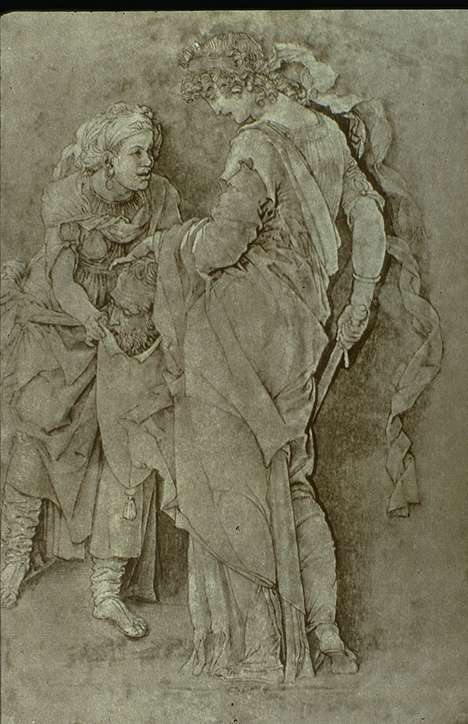
Nick Milne:Mantegna's Judithwas produced, it is believed, in 1491. It's a very simple piece, eschewing the vulgar moment of the Gentileschi and the Caravaggio, but capturing little of the saturated intricacy of the Doré piece. It is instead a bas-relief; almost a cameo, really, particularly with regard to the treatment of Judith's head. It is presented in profile, modelled after Greek or possible Roman parameters, and seems almost ready to be emblazoned upon a coin. The line work itself is highly reminiscent of etching or engraving, and the sum of the matter seems almost as if it has been carved in ivory, or some other likely material. All that said, though, there is something oddly compelling about this particular piece which I can't quite put my finger on. The pose itself is superb, of course; just enough assurance to seem confident, but not enough to seem arrogant. The sword, casually held, is also an excellent touch. The flowing ribbon, like a snake or a single, bewildering braid, is more curious than strictly "good." I certainly have no ojection to it, but it intrigues me too much to be as simple as it would seem to be.
Andrea Mantegna was born in 1431 and died in 1506, which means that his life spanned seventy-five years of one of the most adventurous centuries in the history of art. As a child prodigy, he was exposed to the new thought of the early Renaissance in Italy and its expression in the new art. The physical world was being discovered with eager curiosity. Art responded with a realism that was based-technically- on the scientific investigation of anatomy and perspective.
The classical past was also being rediscovered, and artists tried to emulate its sensuous idealism in forms derived from its broken sculpture and its ruined architecture. These were the elements of a revolutionary art- but at the same time, art continued its revelation of a Christian mystery that contradicts both the reality of the world around us and the pagan world of Greece and Rome. In the fusion of these disparate elements no artist surpassed Mantegna in power and conviction, or in technical mastery. With his magnificent hard-bitten style he is one of the greatest artists of a century that produced more great artists than any before or since.
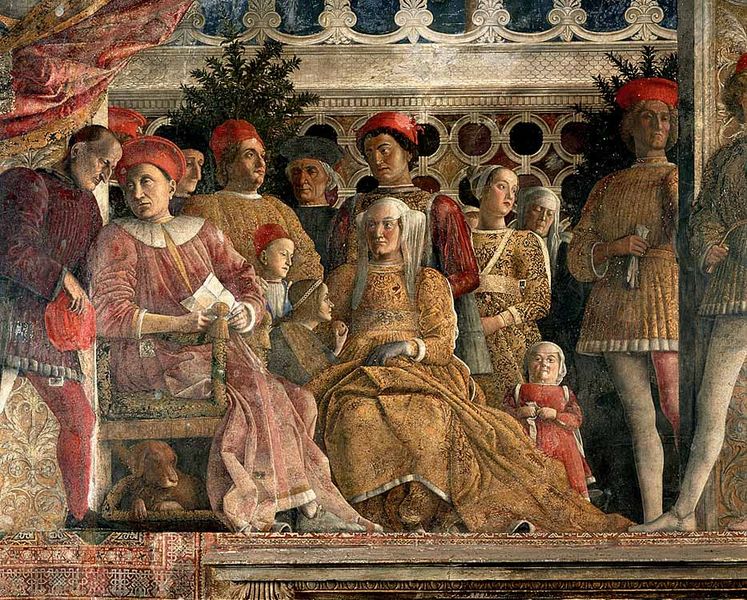
The Gonzagas, as Mantegna portrayed them in the Camera degli Sposi at Mantua, so perfectly embody the dignity and reserve of their court painter's style that it is hard to tell how much is Gonzaga, how much Mantegna. He spent forty-eight years in their service.
As a small child, the son of a carpenter, he was adopted by a painter named Squarcione who had a workshop in Padua. Squarcione is no great figure as an artist nor, from what we can deduce, was he much of a person, and the adoption was not a matter of affection but a practical measure to bind an apprentice to a master. Adoptions of this sort were usual enough for artists or craftsmen who had no sons of their own to train, and Squarcione had several such apprentices, some of whom, including Mantegna, finally had to appeal to the law to sever a connection that was disproportionately profitable to their master.
By all accounts Mantegna became, in effect, the master teacher of Squarcione’s workshop. But if he learned little from Squarcione directly, the workshop was a clearinghouse for new ideas brought to provincial Padua by painters and sculptors from Florence, already a Renaissance city. Although the University of Padua was still essentially medieval, its humanists, who apparently respected Squarcione as an antiquarian, were eager to absorb the new learning. The workshop was a meeting place where artists and scholars discussed classical fragments and classical literature with the intensity once reserved for holy relics and the Bible.
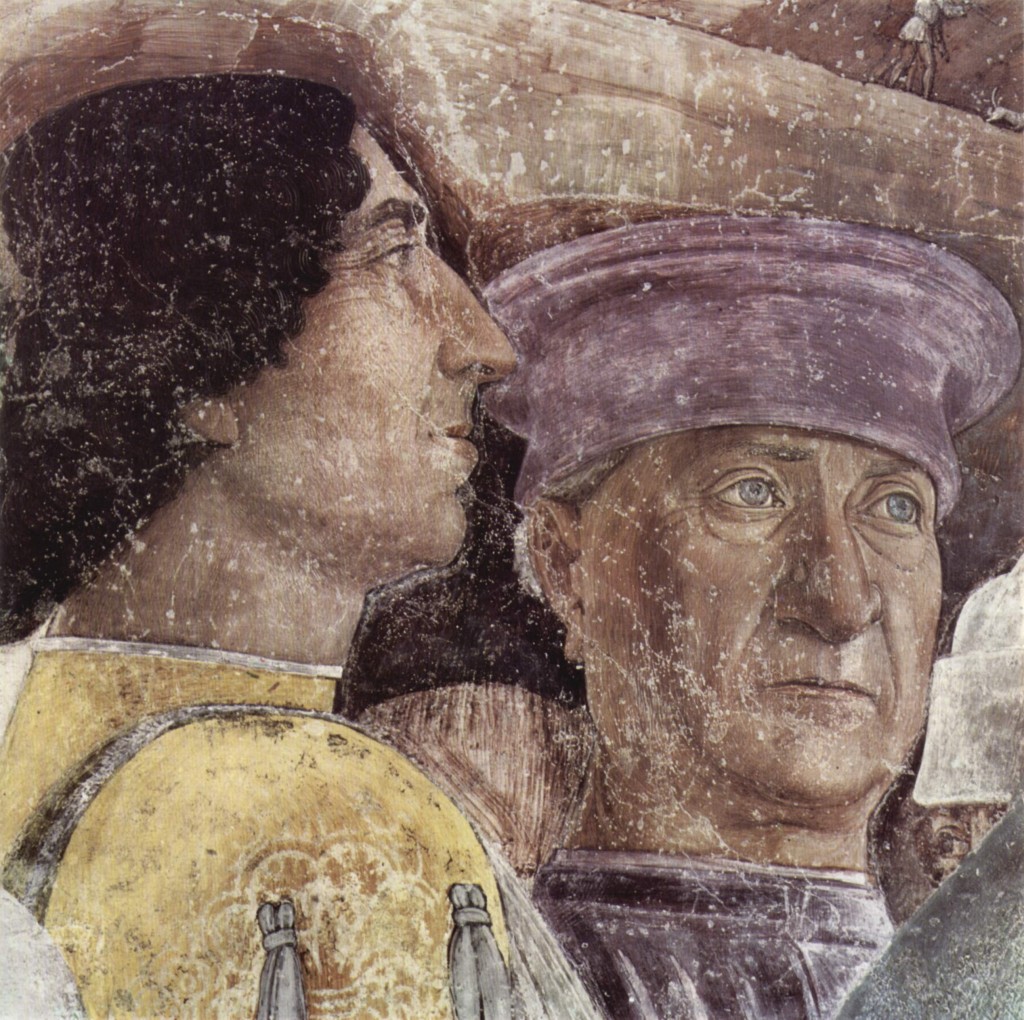
Not all of the participants shown on the walls of the Camera degli Sposi are identifiable with certainty today. The liklihood that Mantegna would have included his self-portrait as an important member of the Gonzaga's entourage, seems to justify identification to the figure on the right in the detail above as the artist.
By the time he was eighteen Mantegna was receiving substantial commissions. At twenty-three he married Nicolosia, the daughter of Jacopo Bellini, the leading Venetian painter. At twenty-five, a highly paid artist of established reputation, he dissolved his contract with Squarcione. At this time he might have gone wherever he pleased, but two years later, in the crucial decision of his life, he entered the service of Lodovico Gonzaga of Mantua, and remained attached to the ducal court for the rest of his life- nearly half a century.
Although he could, and did, travel to the great centers when he wished,his attachment to a provincial court meant that he was more of a spectator than a participant in the movements that transformed art from then on. But it also meant that his own art developed with a consistency, a strength, and an individuality unmodified by the philosophical questioning that affected artists in Florence and Rome. Mantegna remained an artist of the early Renaissance in the fullest expression of its youthful vigor, but he brought to it
mature power of a lifework that advanced steadily and confidently in a single direction.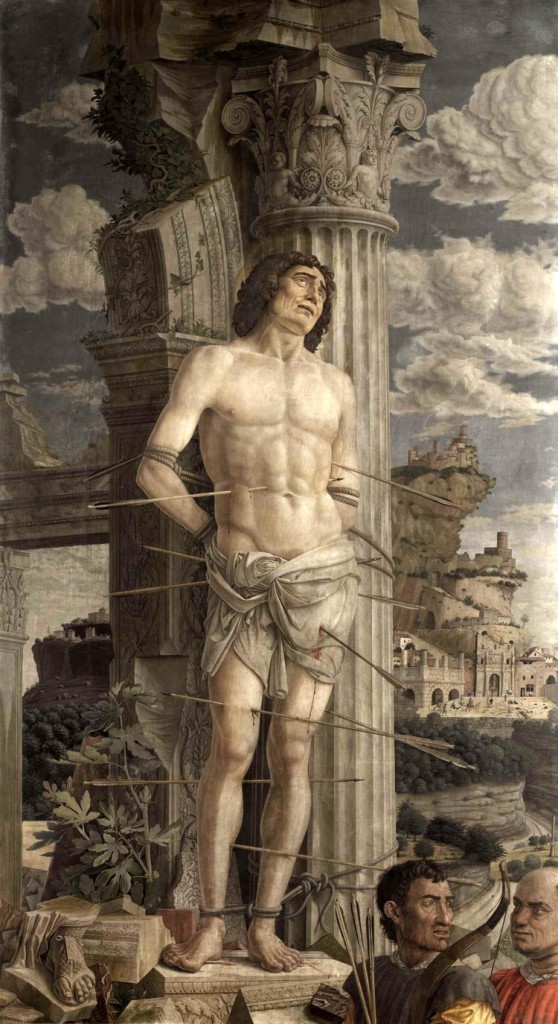
Saint Sebastien, probably painted between 1475-80, shows Mantegna's mastery of the fantastic and the terrible as well as his ability to describe a gruesome martyrdom with paradoxical decorative elegance. The Roman setting of so much of the early history of the Christian church enabled Mantegna to combine his passion for antiquity with the subject matter dictated by commissions for religious paintings. Among these subjects Saint Sebastien was always a favorite; he is usually shown undraped and severely, though not mortally, wounded by arrows-after being left for dead he was rescued by a devout woman, recovered, and was then beaten to death with rods.
If the court of the Gonzaga’s in Mantua was provincial in comparison with the splendid and aggressive courts in Venice, Florence and Rome, it was still the perfect court for Mantegna. The Gonzagas, of all possible patrons, seem to have shared most closely his own characteristics. Their tradition was stern, reserved. Yet as Renaissance humanists they were fascinated by a romantic vision of gthe classical past and were avid for learning, not as a path to social grace, but because they felt an identification between their own vigor and the vigor of an ancient Roman world that they envisioned in heroic terms, a military pageant at a celestial level.
The Gonzagas had a fine sense of the theatrical on a grand scale, and so did Mantegna. Like Mantegna, they made up in masculine energy what they lacked in feminine sensitivity, in strength what they lacked in a taste for contemplation, in alrtness what they lacked in subtlety.

"The influence of Mantegna on the style and tendency of his age was very marked, and extended not only to his own flourishing Mantuan school, but over Italian art generally. His vigorous perspectives and trenchant foreshortenings pioneered the way to other artists; in solid antique taste, and the power of reviving the aspect of a remote age with some approach to system and consistency, he distanced all contemporary competition. He did not, however, leave behind him many scholars of superior faculty...."
If this identification of he Gonzaga’s character with the style of Mantegna’s painting seems too pat, the reason is that we can never visualize the family except as Mantegna showed them in their portraits, assembled along the walls of the Camera degli Sposi in the ducal castle. Any artist who is more than a hack paints something of himself into his portraits of no matter whom; he frequently tells you more about himself than about his sitters. But Mantegna’s association with the Gonzagas was too long and its course, over-all too harmonious to have been based on anything but a response between sympathetic natures. Hence if we have turned the Gonzagas into Mantegna’s, surely any error is only one of degree.
Were there ever people more firm, more assured in their sense of power without arrogance, more calm in the face of inspection, more aware in the presence of the observer without admitting them to their confidence, than the Gonzagas as Mantegna shows them in the Camera degli Sposi? Each one of them is a monument to himself. Each exists with a decisiveness and an assurance that puts the word “dignity” beside the point. They are hard, strong and vital-adjectives perfectly descriptive of Mantegna’s art- and while they are united to one another in unquestioning conviction of the ends they share, each holds himself apart as a man responsible first to himself.
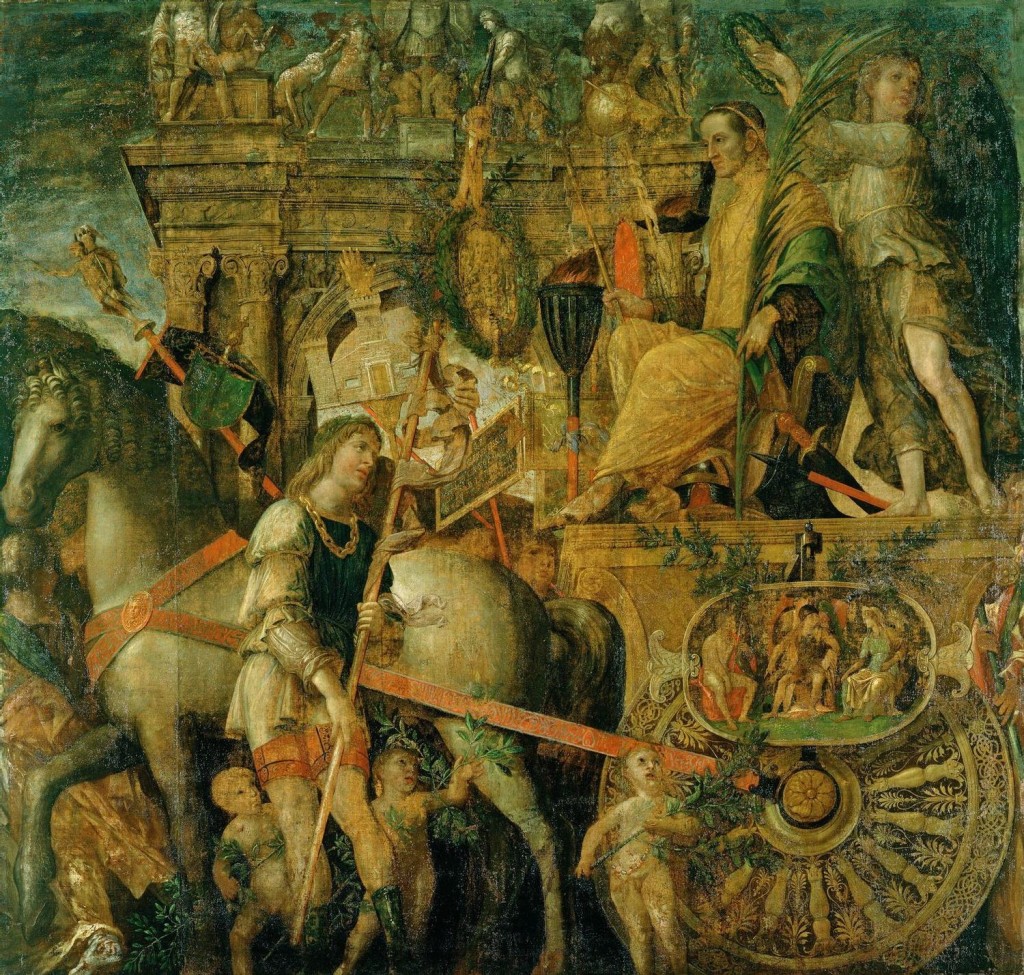
Mantegna. The Triumps of Ceasar. 1484-92. "The profound enthusiasm for the civilization of ancient Rome that infuses his entire oeuvre was unprecedented in a painter. In addition to its antiquarian content, his art is characterized by brilliant compositional solutions, the bold and innovative use of perspective and foreshortening and a precise and deliberate manner of execution, an aspect that was commented upon during his lifetime. He was held in great esteem by his contemporaries for his learning and skill and,..."
Mantegna , too, was an individualist- one of the great individualists in the history of art. We may trace his apparent debts to other artists and point out that his preoccupations with perspective, anatomy, and the classical past were common to all Italian artists of his century. But essentially, he stands alone, individualistic in his use of these discoveries. He is so isolated that he is often misjudged, misinterpreted because he cannot be understood by the standards applicable to his contemporaries in other, more prolific schools of Renaissance art.
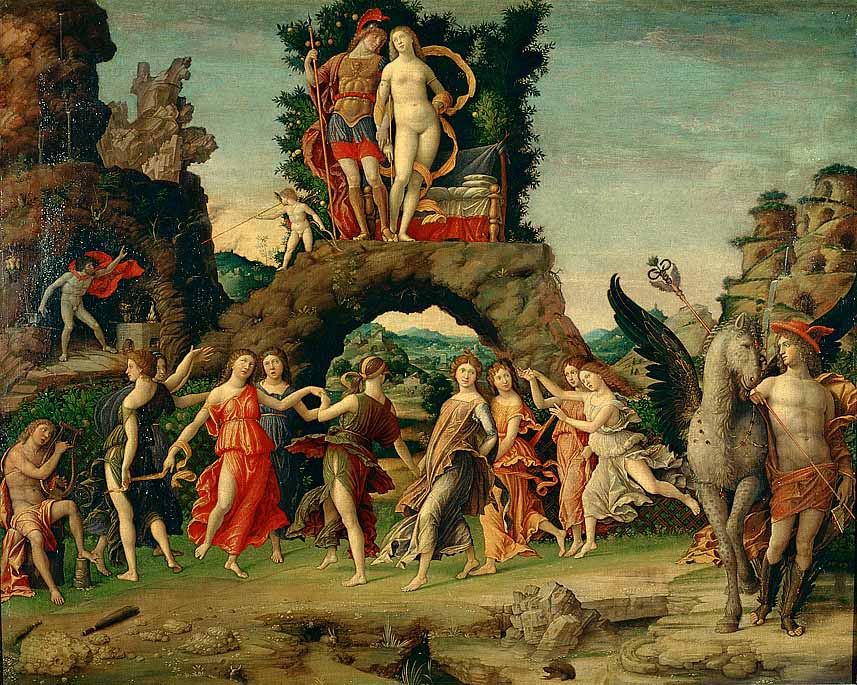
Parnassus."Mantegna's later works varied in quality. His largest undertaking, a fresco series on the Triumphs of Caesar (1489, Hampton Court Palace, England), displays a rather dry classicism, but Parnassus (1497, Louvre, Paris), an allegorical painting commissioned by Isabelle d'Este, is his freshest, most animated work. His work never ceased to be innovative. In Madonna of Victory (1495, Louvre), he introduced a new compositional arrangement, based on diagonals, which was later to be exploited by Correggio, while his Dead Christ (Pinacoteca di Brera, Milan) was a tour de force of foreshortening that pointed ahead to the style of 16th-century Mannerism. One of the key artistic figures of the second half of the 15th century, Mantegna was the dominant influence on north Italian painting for 50 years. It was also through him that German artists, notably Albrecht Dürer, were made aware of the artistic discoveries of the Italian Renaissance. "
ADDENDUM:
Giorgio Vasari eulogizes Mantegna for his courteous, distinguished and praiseworthy deportment, although there are indications of his having been not a little litigious in disposition. With his fellow-pupils at Padua he had been affectionate; and for two of them, Dario da Trevigi and Marco Zoppo, he retained a steady friendship. That he had a high opinion of himself was natural, for no artist of his epoch could produce more manifest vouchers of marked and progressive attainment. He became very expensive in his habits, fell at times into difficulties, and had to urge his valid claims upon the marquis’s attention. After his return to Mantua from Rome his prosperity was at its height, until the death of his wife. He then formed some other connection, and became at an advanced age the father of a natural son, Giovanni Andrea; and at the last, although he continued launching out into various expenses and schemes, he had serious tribulations, such as the banishment from Mantua of his son Francesco, who had incurred the marquis’s displeasure. Perhaps the aged master and connoisseur regarded as barely less trying the hard necessity of parting with a beloved antique bust of Faustina. Very soon after this transaction he died in Mantua, on the 13th of September 1506.





 COMMENTS
COMMENTS